Car Part Repair or Replace Decision Tool
Vehicle Part Selection
Input Relevant Criteria
Decision Result
Select a car part and input criteria to see the recommendation.
Keeping a car running smoothly often comes down to the tiny decisions you make about Car parts the individual components that make up a vehicle. Some parts can be fixed for a few dollars, while others are cheaper and safer to swap out entirely. Below is a no‑fluff roadmap that tells you exactly when to repair and when to replace, so you stop guessing and start acting.
Quick Decision Cheat Sheet
- If wear exceeds 70% of the part’s life expectancy → replace.
- If a single component failure compromises safety (brakes, steering, tires) → replace.
- If labor costs exceed 50% of a new part’s price → replace.
- If the part is a consumable with a short design life (oil filter, spark plugs) → replace.
- If you can restore original specifications for under $100 and the part is not safety‑critical → repair.
Brake Pads - Stop Repairing, Start Replacing
Brake pads grind, squeal, or thin out as friction does its job. The wear indicator usually appears when only 3mm of material is left. Because braking performance drops dramatically, a brake pad friction material that presses against the rotor to slow the car should be replaced, not resurfaced. Even a high‑quality repair kit costs under $30, but it can’t bring the friction coefficient back to factory levels.
Timing Belt - Replace Before It Breaks
A timing belt keeps the camshaft and crankshaft in sync. If it snaps, engine valves hit pistons - a catastrophic repair that can run into thousands. Most manufacturers set a 60,000‑80,000mile interval. Since a fresh belt costs $100‑$150 plus labor, the safe move is to replace at the first sign of cracks, fraying, or oil contamination. Timing belt a reinforced rubber belt that times engine valve operation is not a viable candidate for patch‑up.
Battery - When Repair Stops Making Sense
A car battery’s capacity drops about 5% per year. If a load test shows less than 9.6V on a fully charged unit, replacement is usually cheaper than re‑conditioning. Most auto shops charge $20‑$30 for a re‑condition service, but a new battery (average $120) lasts 4‑5years. Because a weak battery can leave you stranded, the rule of thumb is: replace when voltage under load falls below 9.6V or the battery is over 4years old.
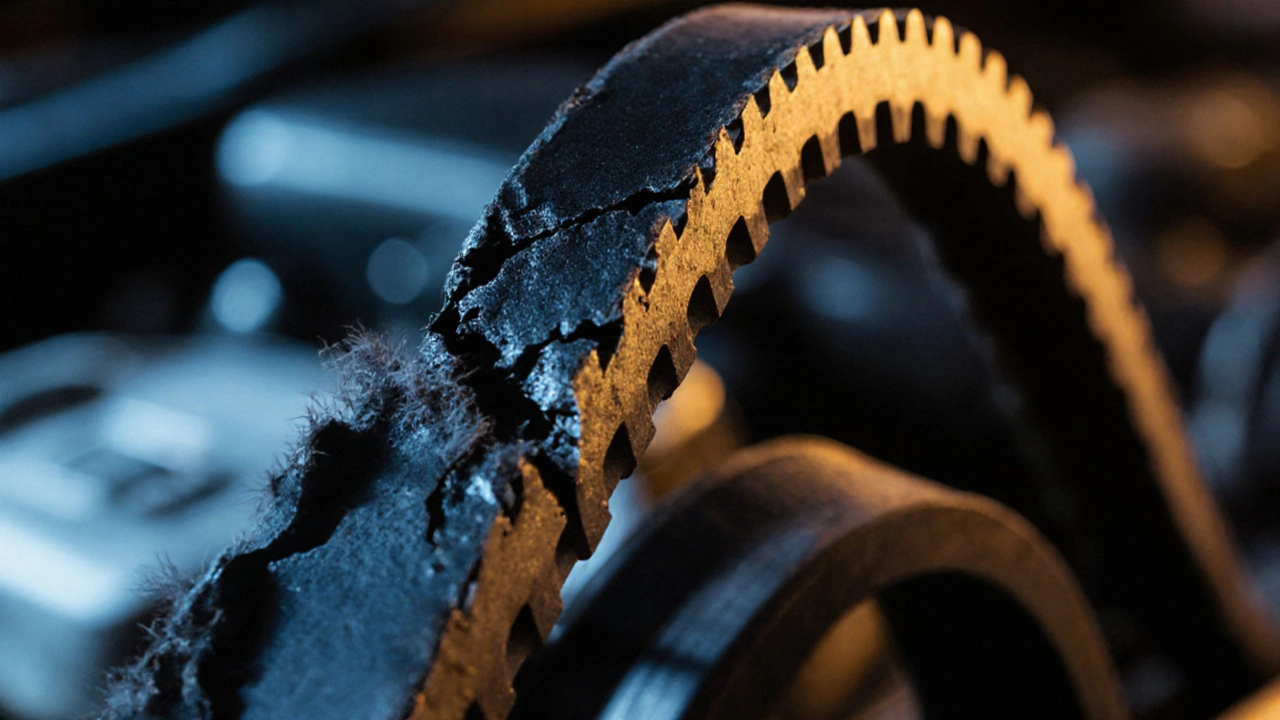
Alternator - Repair Only If It’s Cheap
The alternator generates electricity while the engine runs. Common failures are worn bearings or a bad voltage regulator. If the cost of a rebuilt unit is under $150 and labor is modest, you can repair a failing alternator. However, a brand‑new alternator typically costs $200‑$300, and the lifespan of a repaired unit is usually half that of a new one. Alternator the generator that charges the battery and powers electrical systems while the engine runs should be replaced when output drops below 13.5V at idle.
Tires - Safety Comes First
Tread depth below 2/32in, sidewall cracks, or bulges indicate a tire must be replaced. Patching a tire is okay only for a puncture in the tread area, less than ¼in wide, and when the sidewall is untouched. The cost of a good repair kit is $15, but a new all‑season tire averages $120‑$150. Because tire failure can cause loss of control, the safe answer is: replace unless the puncture meets the patch‑guidelines.
Suspension Components - Replace When Play Shows Up
Shocks, struts, and control arms wear unevenly. If you hear clunking over bumps or notice excessive body roll, it’s time to replace. While some shops offer “rebuild” services for struts at about $50, the performance loss after a rebuild is noticeable. Suspension the system of springs, shock absorbers, and linkages that connects a vehicle to its wheels parts are critical for handling, so replacement is usually the better choice.
Transmission - Major Repairs vs Full Swap
Transmission fluid leaks, slipping gears, or delayed engagement signal internal damage. A solenoid or filter replacement may cost $150‑$250, but a full rebuild often exceeds $1,200. If the vehicle is older than 150,000miles and the repair bill approaches 60% of a new transmission’s price, replacement (or even a reliable used unit) makes more economic sense. Transmission the gearbox that transfers engine power to the wheels is a high‑cost component where a cheap fix rarely restores original performance.
Spark Plugs - Replace Like Clockwork
Spark plug gaps widen and electrodes erode. A misfire, reduced fuel efficiency, or rough idle usually means the plugs need swapping. Even the most premium iridium plug costs $8‑$12 each, and most manufacturers recommend replacement every 30,000‑50,000miles. Repair isn’t an option; you simply replace. Spark plug the device that ignites the air‑fuel mixture in the combustion chamber works best when fresh.
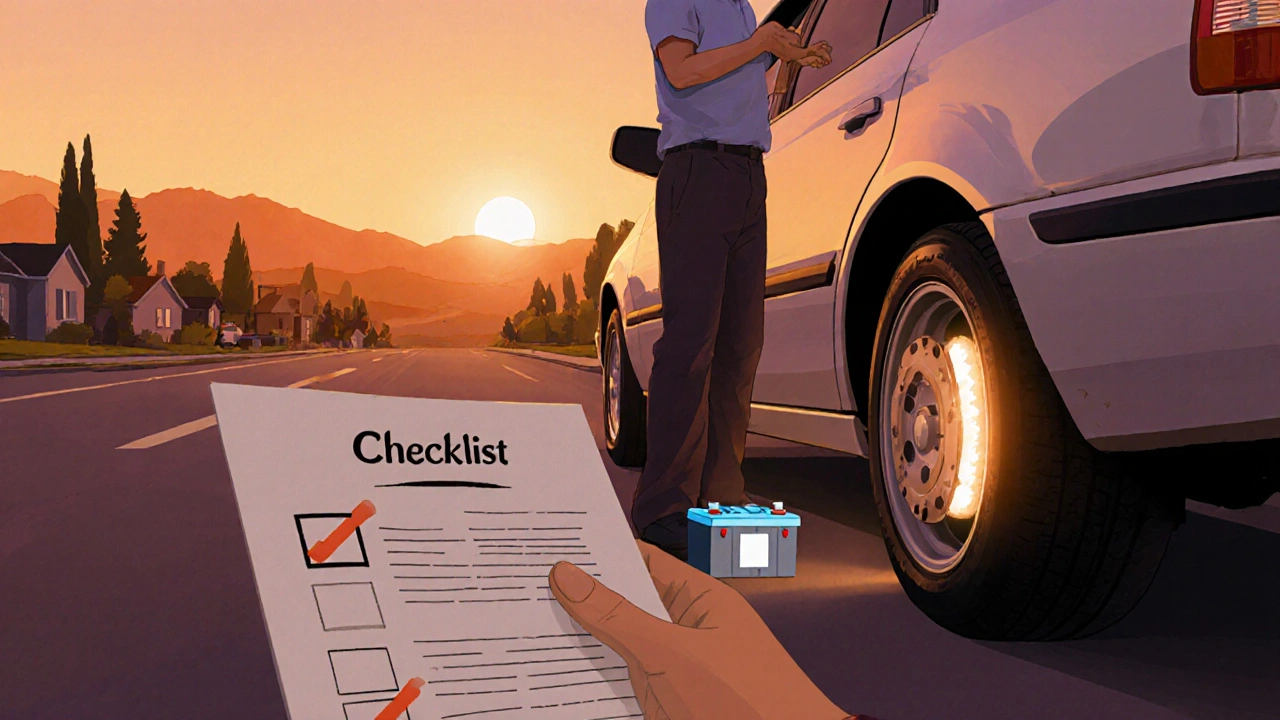
Oil Filter - Change Every Service
Oil filters capture contaminants. A clogged filter raises oil pressure and can starve the engine. Since a standard filter costs $5‑$10 and replacement takes minutes, there’s no debate - change it at every oil change. Oil filter a disposable filter that removes particles from engine oil is a consumable that should never be repaired.
Repair vs Replace Decision Table
| Criterion | Repair | Replace |
|---|---|---|
| Safety impact | Low (non‑critical components) | High (brakes, tires, steering) |
| Cost ratio (labor vs part) | Labor <50% of new part price | Labor ≥50% of new part price |
| Part lifespan left | >30% of original life | ≤30% of original life |
| Availability of quality rebuilds | Yes (e.g., alternator, shocks) | No (e.g., timing belt, battery) |
| Warranty considerations | Typically voids warranty | Maintains or extends warranty |
Checklist Before You Decide
- Inspect the part for visible damage, wear, or leaks.
- Consult the vehicle’s service manual for mileage limits.
- Get a diagnostic quote that breaks down labor vs part cost.
- Ask the shop if a certified rebuilt unit is available and compare warranties.
- Weigh safety implications - never compromise on brakes, steering, or tires.
Why car parts repair Might Still Be Worth It
When the repair cost is under $75 and the part isn’t safety‑critical, fixing it can keep your budget in check and reduce waste. Examples include a leaking radiator hose (replace the hose, not the whole radiator) or a worn serpentine belt (replace the belt alone). In those cases you’re extending the life of a larger, more expensive component.
Frequently Asked Questions
How often should I replace my brake pads?
Most brake pads last between 30,000 and 70,000miles. Replace them when the wear indicator squeaks or the friction material is thinner than 3mm.
Can I safely repair a cracked timing belt?
No. A timing belt is a single‑use component. Any crack means replacement is mandatory to avoid engine damage.
Is it cheaper to replace a battery than to re‑condition it?
Yes. Re‑conditioning costs $20‑$30 and often only adds a few months of life. A new battery provides 4‑5 years of reliable service for roughly $120.
When is it okay to patch a tire?
Only for punctures in the tread, less than ¼in wide, with no sidewall damage. Anything else means replace the tire.
How do I know if my alternator needs replacement?
If the voltage at idle drops below 13.5V or the battery repeatedly dies, the alternator likely needs replacement. Minor bearing noises may be repaired, but overall output loss calls for a new unit.
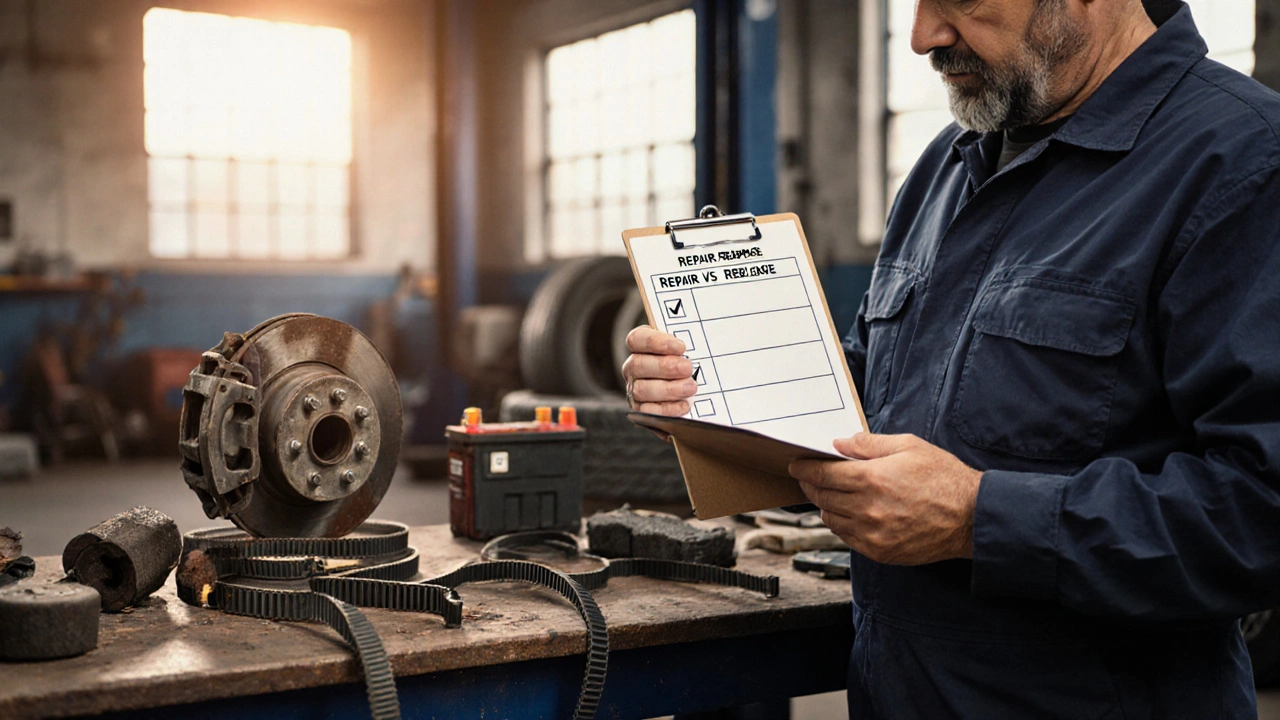

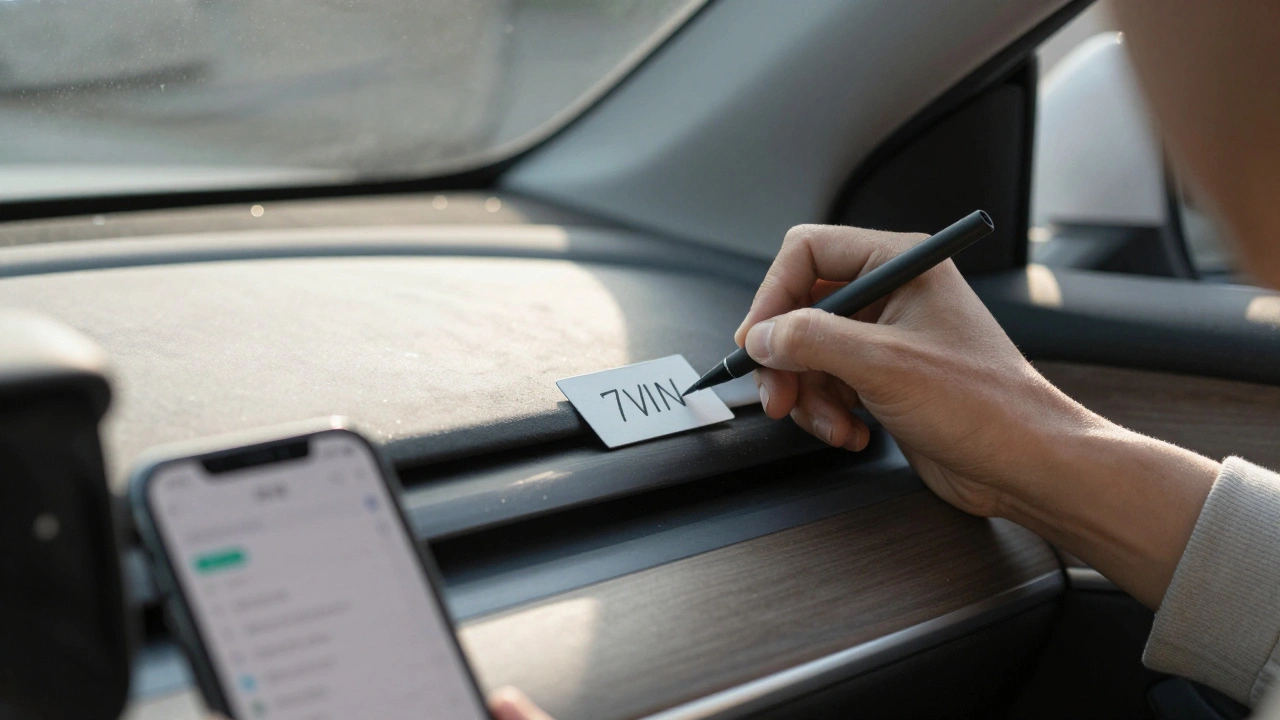

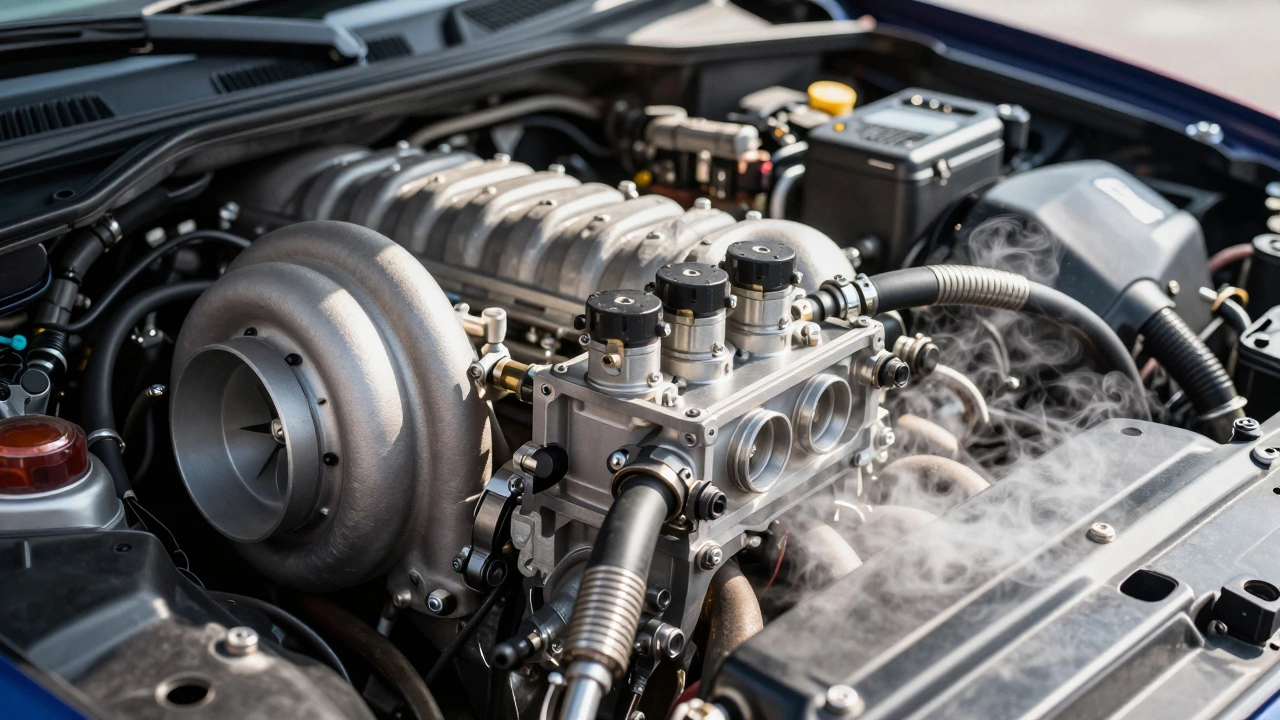

amber hopman
October 7, 2025 AT 22:30I appreciate the clear safety thresholds you laid out, especially the 70% wear rule. It helps me decide when a part is truly at the end of its life instead of guessing. For brake pads, the wear indicator is a solid cue, so replacing them makes sense. I also like the cost‑ratio tip; keeping labor under half the price of a new part saves a lot in the long run.
Overall, the guide feels practical and not overly technical.
Jim Sonntag
October 7, 2025 AT 22:38Nice, because I was really missing another checklist to fill out on my lunch break.
Deepak Sungra
October 7, 2025 AT 22:46Yo, the battery section hits home. I’ve been reconditioning one for ages, but after a couple of years it just won’t start. The 9.6 V under load rule is solid – if it’s below that, you’re basically carrying a dead weight in your trunk.
Also, a fresh battery for $120 is nothing compared to getting stranded at a red light. Just swap it out when it’s over four years old, no drama.
Samar Omar
October 7, 2025 AT 23:03Allow me to indulge in a slightly grandiloquent reverie on the philosophical underpinnings of automotive stewardship. When one contemplates the dichotomy of repair versus replacement, one must first acknowledge the existential dread inherent in the mechanistic decay of silicon and steel. The very notion of a timing belt, a sinewy loop of reinforced polymer, serves as a metaphor for the inexorable march of time; its rupture heralds the annihilation of synchrony within the engine's heart.
Consequently, the prescriptive replacement at the slightest hint of fissure is not merely a recommendation but a covenant with destiny. Moreover, the ethical dimension of safety‑critical components, such as brakes, transcends fiscal considerations; the moral imperative to safeguard human life supersedes any pecuniary calculus.
In the realm of consumables, oil filters epitomize the transient nature of utility; their disposability underscores a broader ecological commentary on planned obsolescence.
Thus, the guide’s emphasis on a 70% wear threshold aligns with an almost Stoic acceptance of impermanence. One might argue that the 50% labor‑to‑part cost ratio is an embodiment of the ancient principle of proportionality, ensuring that the act of repair does not become a Sisyphean endeavor.
Yet, let us not overlook the psychosocial gratification derived from the act of refurbishment; the tactile intimacy of coaxing a failing alternator back to life offers a fleeting communion with the machine’s soul.
In summation, the interplay between economic prudence, safety mandates, and existential reverence coalesces within this guide, rendering it a veritable compendium for the erudite gearhead.
chioma okwara
October 7, 2025 AT 23:20Actually, the battery reconditioning process can add a few hundred cycles if done correctly, not just a few months as some say. Also, the voltage under load test should be performed at 6.6 V for a 12 V system if the engine is off, not 9.6 V as you mentioned.
John Fox
October 7, 2025 AT 23:36Sounds solid. I’ll eyeball the wear percentages next time I’m at the shop.
Tasha Hernandez
October 7, 2025 AT 23:53Oh, joy! Another riveting discourse on when to patch a tire. Because nothing says “thrill” like checking if a puncture is under a quarter‑inch and in the tread. If it passes, go ahead and slap a patch on it, and if not, enjoy the extra $120 you’ll spend on a fresh rubber donut.
Anuj Kumar
October 8, 2025 AT 00:10They don’t tell you this, but most alternators are secretly designed to fail after 30,000 miles – it’s a conspiracy by the parts industry.
Christina Morgan
October 8, 2025 AT 00:26Great job breaking down the safety criteria! I always tell my friends to double‑check the tread depth and watch for sidewall cracks. If you’re ever unsure, a quick visit to a reputable shop can save you a lot of hassle. Keep sharing these practical tips, they’re super helpful for DIYers like me.
Kathy Yip
October 8, 2025 AT 00:43Interesting take on the repair versus replace dilemma. I wonder if there’s a deeper philosphical meaning behind the 70% wear rule – perhaps it reflects our own thresholds for letting go of the old and embracing the new? Anyway, great info.
Jack Gifford
October 8, 2025 AT 01:00Just a minor note: the guide says “timing belt replacement is mandatory regardless of wear,” which is spot‑on. However, you might want to add that many modern engines use timing chains that have different service intervals.
Sarah Meadows
October 8, 2025 AT 01:16From an engineering standpoint, the cost‑benefit analysis of part replacement is non‑negotiable; you must prioritize performance metrics over sentimental attachment.
Nathan Pena
October 8, 2025 AT 01:33The article is decent but overlooks the statistical variance in labor costs across regions. A blanket 50% threshold is overly simplistic; in high‑wage areas, even a 30% ratio can be prohibitive. Also, the recommendation to replace any safety‑critical component without exception ignores the possibility of certified refurbishments that meet OEM standards.
Mike Marciniak
October 8, 2025 AT 01:50Did you know that most alternators are secretly equipped with a backdoor that allows manufacturers to disable them remotely? Think about it.
VIRENDER KAUL
October 8, 2025 AT 02:06In concluding this discourse, it is imperative to reiterate that the decision matrix presented herein is predicated upon quantitative thresholds-specifically, wear exceeding seventy percent, labor costs surpassing fifty percent of the part’s market price, and the classification of the component as safety‑critical. These parameters, when applied uniformly, yield a deterministic recommendation: replace. Nevertheless, variance in regional labor rates and the availability of OEM‑certified refurbished units may necessitate a nuanced application of the guidelines. Consequently, practitioners are advised to supplement the algorithmic output with contextual intelligence derived from empirical service data.